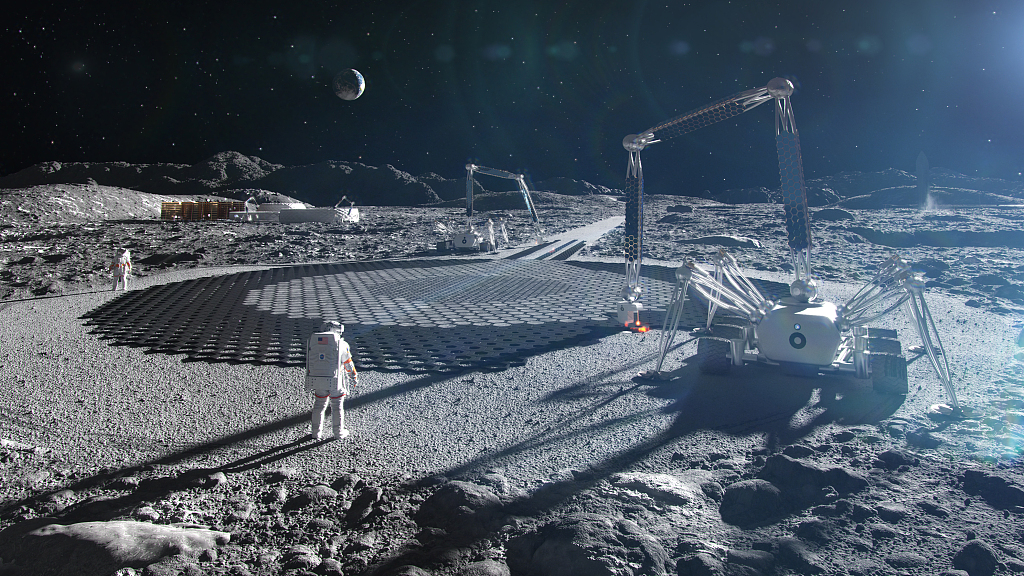
An imaginary illustration of human beings working on a lunar base. /CFP
An imaginary illustration of human beings working on a lunar base. /CFP
NASA's Orion capsule barreled through Earth's atmosphere and splashed down in the Pacific Ocean on Sunday after making an uncrewed voyage around the moon, winding up the inaugural mission of the U.S. agency's new Artemis lunar program 50 years to the day after Apollo's final moon landing.
This is the first mission in NASA's Artemis lunar program, which is expected to land astronauts on the moon by its third mission in 2025.
The agency wants to build a lunar space station called Gateway and keep a sustained presence on the moon to gain insight into how to survive very long space missions, ahead of a mission to Mars in the 2030s.
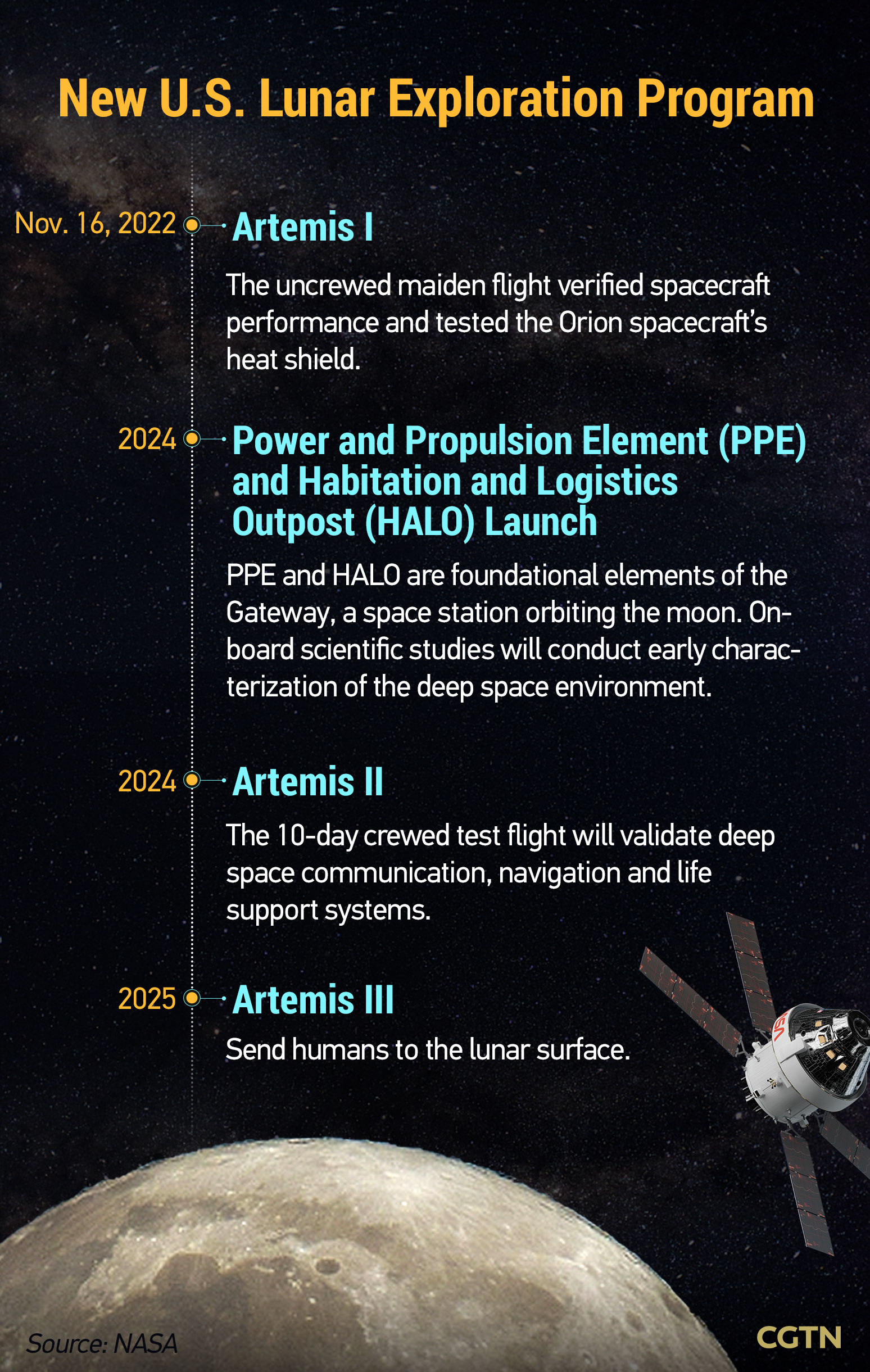
Graphic by CGTN's Liu Shaozhen
Graphic by CGTN's Liu Shaozhen
The United States isn't the only one to send missions to the moon.
Seen from the history, the Soviet Union launched its first spacecraft to reach the moon in September 1959 and sent the first cosmonaut, Yuri Gagarin, into space in April 1961. And it's been over half-centenary of Apollo 11's moon landing and Neil Armstrong's famous line about a small step for a man on July 20, 1969.
1. Russia's exploration to the moon
Russia reactivated its lunar program these years, which includes three successive missions with Luna-25, Luna-26 and Luna-27, according to the Space Research Institute of the Russian Academy of Sciences.
Its launch of Luna-25, with the aim to land near the moon's South Pole, was postponed several times. The mission could be postponed to 2023, according to TASS, citing the Roscomos Director General Yury Borisov.
2. Lunar exploration of ESA
The European Space Agency (ESA) has also play a role in lunar exploration. The agency in 2003 launched SMART-1, a moon-orbiting probe, making it the first lunar exploration in the 21st century.
It also signed up a European rocket maker to go to the moon before 2025 and establish a moon base, mining the lunar regolith.
Apart from independent research, the agency also cooperates with other countries in lunar exploration. The ESA provides service modules for NASA's Orion on propulsion, life support, power, air and water, and controlled the temperature in the crew module.
The ESA said it wanted to "buy a ride on a commercial lander" to deliver equipment to the moon's surface for research and they were "ready to pay the 'roaming charges' to talk to hardware."
Meanwhile, the agency in April 2022 announced the ending of cooperation with Russia on a series of lunar missions, including Luna-25 and Luna-27 landers and the Luna-26 orbiter.
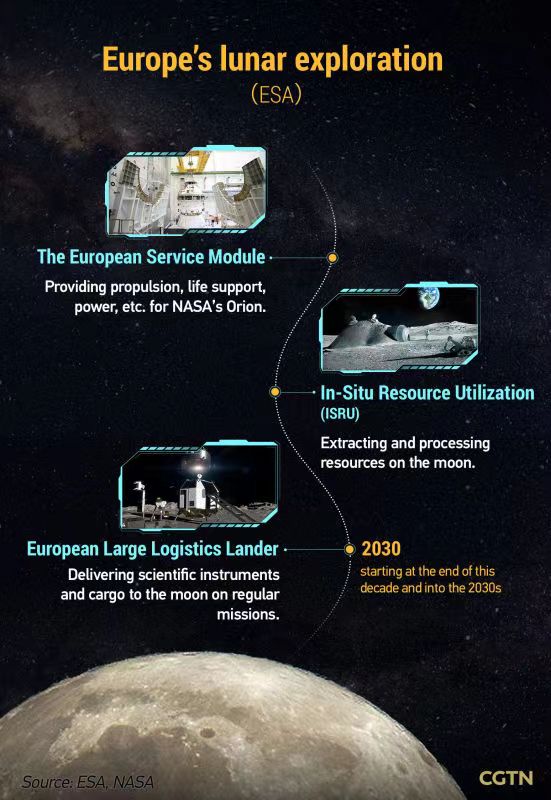
Graphic by CGTN's Liu Shaozhen
Graphic by CGTN's Liu Shaozhen
3. India's lunar exploration plan
India's first mission to the moon, Chandrayaan-1, was launched on October 22, 2008. The spacecraft was orbiting around the moon at a height of 100 km from the lunar surface for chemical, mineralogical and photo-geologic mapping of the moon. It detected water in vapor form in trace amounts, according to the Indian Space Research Organization (ISRO).
The country's first mission to make a soft landing on the moon with the Chandrayaan-2 probe failed in 2019 when its lander and rover crashed minutes before landing.
After much delay due to the COVID-19 pandemic-induced lockdown, the first pictures of the Chandrayaan-3 mission to the Moon have arrived.
The country's Chandrayaan-3 mission is expected to be launched in August 2023, reported The Hindu on October 20, citing ISRO's Chairman Shri S. Somanath.
It added that preparation for the country's maiden manned mission into space was progressing with an expected launch date of December 2024, with the aspiration to the moon and Mars.
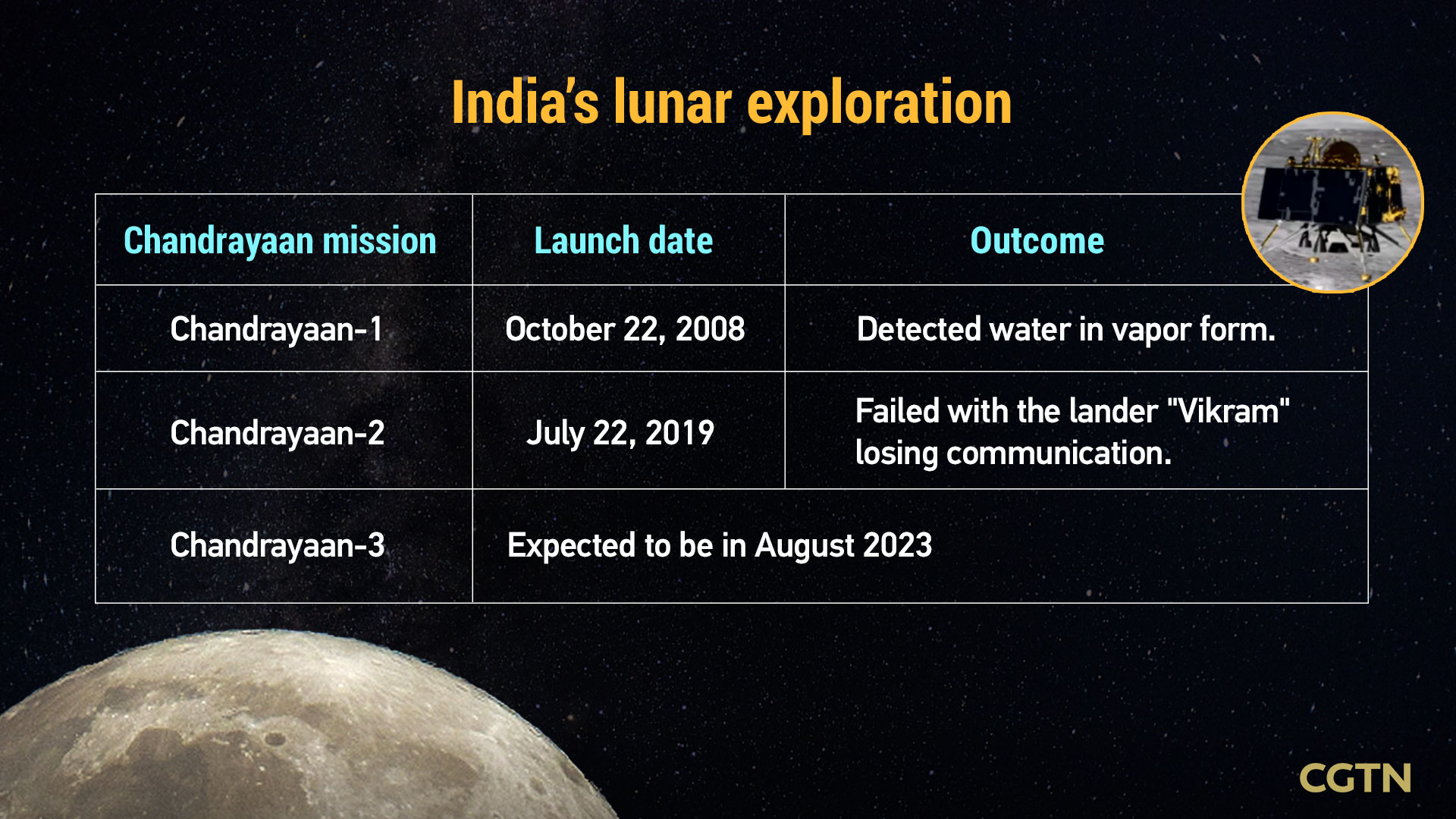
Graphic by CGTN's Liu Shaozhen, Yin Yating
Graphic by CGTN's Liu Shaozhen, Yin Yating
4. Japan's lunar exploration
Japan's first lunar probe, Hiten, was launched in 1990 with an objective of studying navigational technology for orbital control.
It scheduled to put a Japanese person on the moon by the latter half of the 2020s with the help of NASA's Artemis program, according to the Kyodo News.
The country's lunar lander, Smart Lander for Investigating Moon (SLIM), aiming to demonstrate accurate lunar landing techniques by a small explorer, has been postponed to 2023, NHK reported in September.
Japanese company ispace launched its HAKUTO-R Mission 1 lunar lander on a SpaceX Falcon 9 rocket on Sunday in Florida, the U.S. The company said that the mission would perform a soft landing on the moon. If the mission is a success, it will be the first spacecraft funded and built by a private firm to land on the moon.
5. China's exploration to the moon
China's lunar exploration program was approved in 2004. It has finished its three-step lunar exploration program of orbiting, landing and return when the Chang'e-5 lunar probe brought back 1,731g of samples from the moon in December 17, 2020.
This is not an end to the country's lunar exploration. The country has started the fourth phase of lunar exploration program, including the Chang'e-6, Chang'e-7, and Chang'e-8.
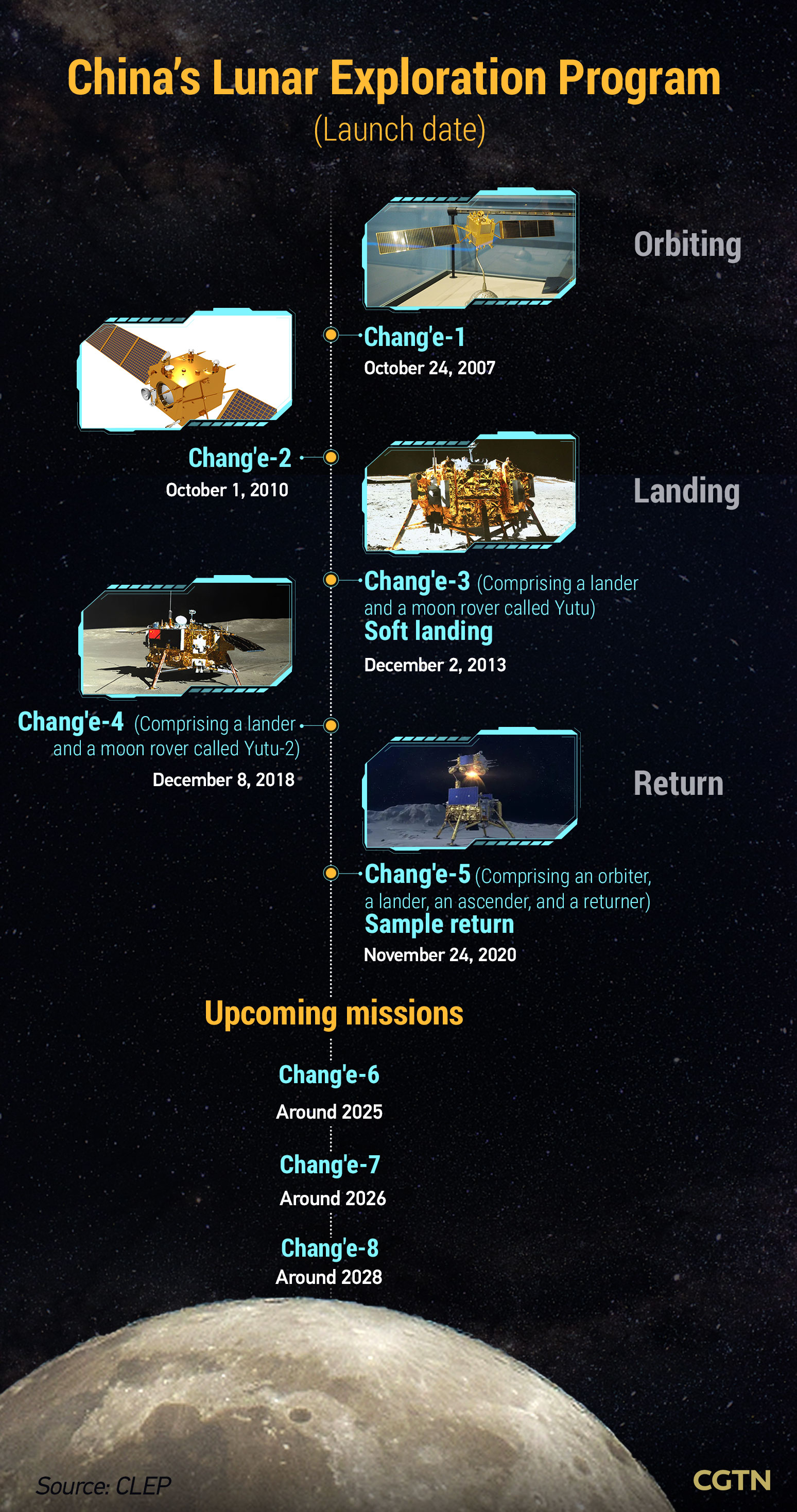
Graphic by CGTN's Liu Shaozhen, Yin Yating
Graphic by CGTN's Liu Shaozhen, Yin Yating
Among them, Chang'e-6 is set to collect samples from the far side of the moon and bring them back to Earth, Wu Weiren, chief designer of China's lunar exploration program and academician of the Chinese Academy of Engineering, said in an interview on November 24.
The Chang'e-7 mission is going to land on the moon's South Pole and have a flyover to search for water in the caves at the moon's South Pole that never sees sunlight, according to the chief designer.
Chang'e-8, which will be launched around 2028, will form the basis of a scientific research station at the moon's South Pole with Chang'e-7, said Wu, adding that the station will include a lunar orbiter, lander, rover, a flying vehicle and multiple scientific instruments.
China has long called for cooperation, rather than a space race. The country calls on all countries to carry out in-depth exchanges and cooperation in outer space on the basis of equality, mutual benefit, peaceful utilization, and inclusive development.
According to Wu, China is studying the feasibility of building internet communications on the moon to integrate data relay, navigation, and remote sensing, which is expected to achieve effective management of the lunar probes.
(With input from agencies)
Read more:
NASA launches Artemis 1 lunar mission
NASA's Orion spacecraft makes its closest flyby of moon
China offers int'l cooperation opportunity via Chang'e lunar missions